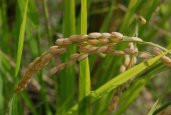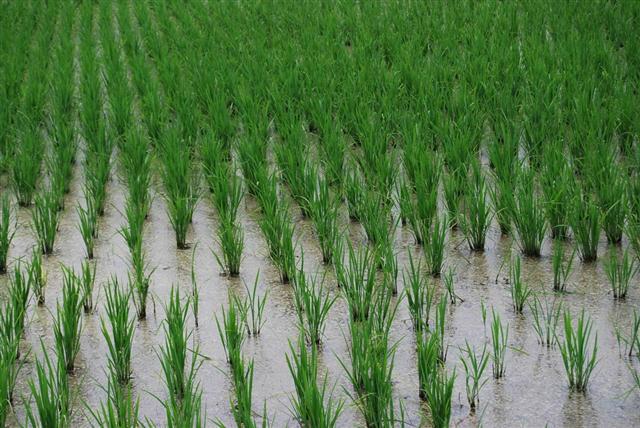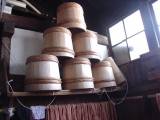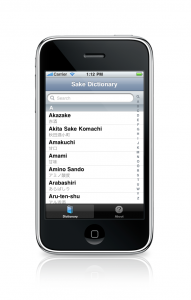|
|
|
Greetings to All Readers,
Spring is just around the corner, at least as far as the calendar is concerned. Here in Japan, we have had the coldest winter in a quarter century. Record lows in many areas combined with heavy snowfalls have burdened quite a few people this year. And of course, the silver lining is that all this cold is good for sake brewing. And this follows a fairly decent year for rice, too, so that we can expect good things from this year’s brewing season.
My apologies for missing the February newsletter. Every year I promise myself that I will control the flow of events so that I do not become buried, but the sheer volume of work in the months in which most sake is brewed make that a goal beyond my means at that time. Next year!
Finally, in terms of content, this month we look at the Japan-California rice connection, as well as a snapshot of the industry today, and a couple more topics. Kick back with a glass of sake and relax while reading!
Enjoy the newsletter,
John
John
 
|
Cal Rose Rice = Wataribune Rice = Omachi Rice?
Well, not quite, but...
Most of the sake being made in North America, be it made at one of the
 |
|
several large production facilities, or one of the few smaller facilities, is made using a rice known as “Calrose.” But what most people may not know, is that that rice strain, released to California rice growers in 1948, was originally developed from a rice from Japan, and not just any rice strain, but a sake rice variety.
Yep. It’s true. The rice from which Calrose was created, when it came here from Japan back in 1908, was a rice known as Wataribune. And, in fact, if you go here you can see the proof that Wataribune did indeed go to the US from Japan.
Back then there were nor official designations of sake rice (known more formally as “shuzo kotekimai”) and regular rice. And, a number of rice types were indeed used for both sake making and eating, Wataribune being one, Shinriki being another, and just to beleaguer the point, Kame no O being one more. So while it is not likely that it was brought to the US to make sake, it still found its way there nonetheless.
There are countless strains of rice in the world, two main ones being Japonica and Indica. While there are several differences between the two, one is the length of the longer axis of the grain. Japonica is short-grain, Indica is long-grain. And sake is brewed using short-grain rice.
Could it be done with long-grain rice? Sure, to some degree. But all that sake has become is based on centuries of making it using short-grain Japonica rice, and as such it would likely be much more difficult to replicate today’s sake with long-grain Indica. But I digress.
Back to Calrose, it was developed from a strain of Japonica; and is referred to as a “medium grain” rice strain. And in fact, the “rose” part of the name refers to its somewhat wider structure. Indeed, it seems that Calrose has been brought back to Japan and had its genes pulled down, and its DNA looked at. And some Indica has gotten in there. Originally I thought it was most likely via Indica pollen floating willy-nilly through the fields. But actually, it was a deliberate process successfully performed by Rice Experimentation Station in Biggs, California.
So it ain’t what it was. But it still is good for sake brewing.
But wait! There’s more! Wataribune is a rice that was and is grown in the Kanto region, i.e. in the greater area surrounding Tokyo. While there is no airtight proof, a number of sources have shown that Wataribune is in fact Omachi, a prestigious variety of rice originating in Okayama Prefecture in the western part of Japan, i.e the Kansai region, i.e. the prefectures surrounding Osaka, Kobe and Kyoto. In other words, Omachi was at one point in time brought up to the Kanto area and for some reason renamed as Wataribune.
So, with just a bit of a stretch of the imagination, Calrose is Wataribune is Omachi. While that is admittedly pushing things a bit, maybe more than a bit, it still is some serious lineage!
 |
|
However, that does not mean it is still the same rice, or that it maintains even a remote resemblance. After first crossbreeding, and then more than 60 years of raising it using vastly different cultivation methods, in a different climate, and for different purposes, much has changed in our beloved strain. It looks different, is not as big or voluptuous, and neither are there the trademark characteristics in structure and content– at least not like we find in real Omachi or Wataribune here in Japan.
And this is important, lest we let ourselves go off on a marketing rant. As a comparison, one can take an outstanding grape vine, crossbreed it with another, and then move it to a different part of the world, with a different climate, and grow it in a way that is different from how it had been grown before its travels to the new region. And it would likely not be nearly as suited to its original purpose as its ancestor would be. So while the lineage is there, Calrose is no longer the same rice that its 1908 ancestor was.
This is not to diss it. Not at all! The handful of North American brewers
 |
|
that use it are dong a wonderful job, making for the most part tasty sake, and generally getting better all the time. What would even be better (and it might already be happening) is to see more feedback between those brewers and the rice producers with suggestions on how to grow it to make it even more suited for sake-brewing. Sure, that might drive price up, but it will drive quality up too. And that can only be a good thing in the long run.
|
|
Industry Snapshot
March, 2012
As we approach the March 11 one-year mark since the catastrophic earthquake, tsunami and nuclear accident, the sake industry continues along its paradoxical path of making better sake than any time in history, while at the same time contracting overall. Here is a quick snapshot of things as they are in this moment.
Currently, there are 1272 breweries making at least some sake. This is down 30 from 1302 last year. However, note that not a single brewery went down due to the occurrences of March 11. Every single brewery damaged or destroyed has some how managed to pick themselves up, and continue to make sake this year. Miraculous. While their future may still be perilous, at least they are here, now.
Production for the 2010 brewing year was 440,000 kiloliters, down 6.3% from the previous year. Readers will surely remember that sake is brewed in a period surrounding the coldest months of the year. Smaller brewers might brew from November to February, mid-sized kura from October to April, and behemoth breweries crank it out maybe September to May or longer. So the “Brewing Year” is defined as July 1 to June 30, so as to capture one complete brewing season, no more and no less, and no matter what the scale of enterprise might be. So the 2010 brewing year ran from July 1, 2010 until June 30, 2011. And since we are now in the middle of the 2011 brewing year (that began on July 1, 2011 and will end on June 30, 20112) for all intents and purposes the data is for “last year.”
Also, against the backdrop of the slight drop in sake consumption, it is worthwhile to point out that alcohol consumption in Japan has dropped in recent years as well.
Of those 1272 active breweries, 310 make only premium sake, a small
increase of premium-only brewers. And, a full 31% of all sake made was one of the premium designations. Wow. While I sincerely have nothing against cheap sake, or standard “futsuu-shu,” a movement toward premium is likely a good thing when viewed from the vantage point of long-term survival.
More information will be posted on my blog, as it becomes available, at
http://sake-world.com/wordpress/
Would you like to know when new stories are posted? Please follow me on Twitter.
|
Sake Basics: Nigori
Nigori sake, or more correctly “nigori-zake,” is cloudy sake. Why is it
 |
|
cloudy? Because when completed sake is filtered away from the remaining rice solids, it is passed through a mesh. Nigori-zake is made by deliberately passing it through a coarse mesh that allows some of the lees, or dregs, known as “kasu” to come through.
Why would they do that? Because it is a throwback to sake of over 1000 years ago, when they did not bother to filter it out. While it can be very enjoyable, the presence of that kasu pretty much ensures that nigori will not be as refined or delicate as normal sake.
Note, nigori is mutually exclusive of grade. So you can have a nigori futsuu-shu, a nigori junmai-shu, or even a nigori ginjo-shu. However, since more kasu in your sake goes in the opposite direction of the increased refinement that ginjo brings, rarely do we see nigori-zake amongst the top grades of sake.
Nigori comes in all expressions: sweet, dry, smooth, acidic, thick-n-chunky, and thin. Extremely thin nigori (i.e. just a pinch of kasu) is called “usu-nigori.” While nigori is not that popular in Japan, it is massively popular in many overseas markets. Why? Some say its degree of familiarity. No matter who makes it, it’s called nigori. No matter where it comes from, it’s white. And perhaps the whole pina colada aspect adds to that as well.
The most prominent nigori-zake in Japan is Tsuki-no-Katsura of Kyoto. They have pretty much made an art of it, or at least of marketing it. Rihaku from Shimane is another popular and very enjoyable nigori-zake available around the world.
Now that that's been cleared up, enjoy your nigori!
酒 酒 酒 酒 酒 酒
For more information on what you can do with kasu, the dregs from sake brewing, in your everyday culinary life, see my blog entry here.
Also, to see the state of sake in Australia, check this out.
|
Did You Know? Yields in Sake Brewing.
How much sake can be made from a kilogram (2.2 lbs) or rice? In
truth, it depends on many things, such as how far you let it ferment (sacrificing flavor if you go too far) and how tightly you squeeze the mash to press out the sake (with the same potential downside, i.e. sacrificing quality if you get greedy). But a very short answer would be about 2 liters per kilogram, of junmai-shu at 18%. Water that down to 16% as most sake is and you have about 2.5 liters. Cut that junmai-shu with alcohol to make a honjozo, (non-junmai) ginjo or daiginjo and you have about 2.8 liters.
But again: there is great variation!
|
 Announcements and Events Announcements and Events
Sake Professional Course in Japan
Sometime in July, somewhere in Chicago...
The next Sake Professional Course is scheduled for this July in Chicago. As you can see from the vagary-laden subtitle above, neither the date nor the location are as of yet determined. Should you be interested in receiving more details when they become available, by all means, please send me an email to that purport. The Sake Professional Course, with Sake Education Council-recognized Certified Sake Professional certification testing, is by far the most intensive, immersing, comprehensive sake educational prog ram in existence. Three days of classroom lectures and tastings leave "no sake stone unturned." ram in existence. Three days of classroom lectures and tastings leave "no sake stone unturned."
The cost for the course, is expected tobe $799. For more information about the daily schedule and to read a handful of testimonials, click here . Feel free to contact me directly at sakeguy@gol.com with any questions about the course, or to make a reservation.
Sake Tours, 2012 ~ San-in
On the slim chance that there are very spontaneous readers out there, note that there are a couple of spots available for the tour to Shimane and Tottori taking place in just a few days, from March 12th. Should you be interested, please shoot me an email right away.
Sake Tourism is alive and well! Check out this year's Sake Tours
 |
|
for sake-heavy tourism of Japan. Not nearly as intense as the Sake Professional Courses, and sake is not the only thing you will experience on these special tours! But certainly, they are "sake heavy."
From the website:
Please join us for a very special journey through the regional brewing and culinary traditions of Japan. Tour destinations are filled with moments you cannot experience otherwise. In 2012, we will return to San-in, the land of myth, and great sake.
Meet and speak directly with artisans to appreciate their history, philosophy, and the art of brewing. Learn from the world's best sake educator, John Gauntner, and share the passion of brewers for their craft. Then, wind down at onsen to relax, and simply have fun!
Learn more and register now at the Sake Tours Website.
Sake Education Council Website
Please take a moment to check out the website for the Sake Education Council, the organization behind the Certified Sake Professional and Advanced Sake Professional certifications. We plan to grow steadily, strongly and continually, and we will need the support of all those that love sake to do so. Follow us through the "usual suspects" of social media.
Sake Homebrewer's Online Store
Please be sure to check out Homebrewsake.com for supplies, information and a forum, including lots of supporting information on everything from recipes to history. I have been meaning to mention this site and the gentleman behind it, Will Auld, but have repeatedly forgotten in past newsletters. The site is replete with instruction, augmented with videos, schedules, and more. If you are even remotely interested check this site out right away.
Don't forget the archives!
Older editions of this newsletter are archived here.
Really old editions are archived here.
|
 Sake Education Central Sake Education CentralSake Dictionary App for the iPhone, iPod and iPad
"For 99 cents, this app ROCKS!!"
-a satisfied customer
There you are, perusing a menu, or standing in front of a shelf of great sake, or perhaps reading a sake newsletter… and up pops one of those hairy, pesky sake terms in Japanese. You know you have heard it many times, but dammit, you just cannot remember what it means now…
No problem! Just whip out your iPhone or iPod and fire up your trusty old version of
The Sake Dictionary. In a matter of seconds, you’ll be amongst the cognoscenti once again. But… if only you could pronounce it properly. Now that would really rock!
Done! Just tap on the term and you will hear a clear example of how to pronounce the term in Japanese. Repeat it a couple of times and the term is yours for eternity, to toss about and impress your mates.
What’s more, it’s
less!
Less than what it cost before, much less. Like less than one-seventh less. For a limited time only, the audio-enhanced version of The Sake Dictionary iPhone app is available for a mere $0.99.
|
 |
|
|
The Sake Dictionary is a concise little package of all the terms you might ever come across when dealing with sake. Almost 200 of them - including sake grades, rice variety names, seasonal sake terms, special varieties, rare types, post-brewing processing words and the myriad terms used in sake production - many of which are not even familiar to the average Japanese person on the street - are listed up here with concise, useful and clear definitions and the written Japanese version as well. And now, with the new audio component, you can listen and learn just how to pronounce those terms properly.
Start to toss around Japanese sake terms like you were raised knowing them! Gain a level of familiarity hitherto unimaginable! Avoid frustrating paralysis when faced with a sake-related purchase!
Get your copy of The Sake Dictionary now and never be confused by sake terms - or how to pronounce them - again.
Get it here: http://itunes.com/apps/sakedictionary
(Note if you have already purchased it, this upgrade to the audio version is free. Just go to iTunes and get it!)
|
Stay Subscribed!
Are you not getting this newsletter? I realize that is like asking that "those not present please raise your hand," but for future reference, should you spontaneously stop receiving this newsletter, please go here and sign up again. Should that not work, please go to www.sake-world.com.
Email newsletter services are very careful not to be considered spam enablers, but the problem is that often very valid email addresses come back bounced as invalid. It is an unavoidable problem. So if you or someone you know is not getting this, or stop(s) receiving it inexplicably, please do take a moment to double check that you are still subscribed.
Sincere apologies for the hassle, mixed with gratitude for reading this newsletter. |
I hope you have found the above information helpful and entertaining. For more information about all things sake, please check out www.sake-world.com. Until next month, warm regards, and enjoy your sake. 
Questions and comments should be directed to John Gauntner, at this email address.
All material Copyright, John Gauntner & Sake World Inc.
Regards,
John Gauntner
Sake World, Inc
 . . 
|
|
